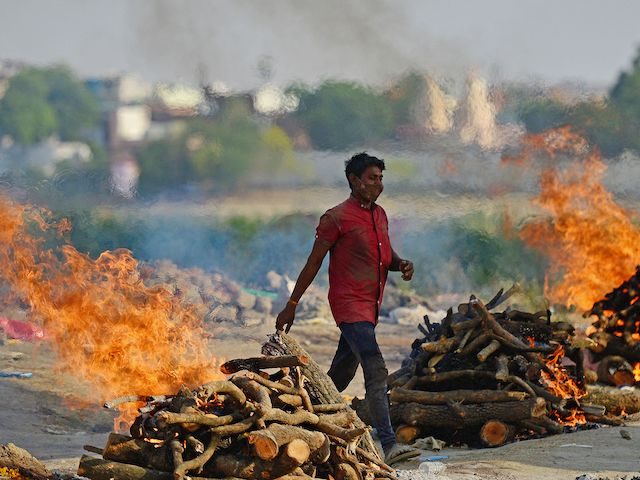A social media account run by the Chinese Communist Party (CCP) mocked India’s deadly coronavirus crisis on Saturday with a post deleted after public outrage in both China and India.
The now-deleted post, depicted below, emanated from the CCP’s Commission for Political and Legal Affairs (CPLA) – one of the most powerful organs of the Party, as it oversees the legal system and law enforcement agencies. The commission’s account on Weibo, China’s tightly-controlled version of Twitter, has 15 million followers. The post was shared by numerous other government and law enforcement social media accounts before it was deleted.
The CPLA post provided a side-by-side comparison between China launching the first module of its space station into orbit versus Indians lighting a funeral pyre to cremate their coronavirus dead.
“China lighting a fire versus India lighting a fire,” the caption read:
Someone apparently thought it was a good idea to make fun of the latest Covid-19 outbreak in India? An acct affiliated with CCP Central Political and Legal Affairs Commission posted this on Weibo. Caption: When China sets things on fire vs when India does it. pic.twitter.com/cJTXT9Lbws
— Mengyu Dong (@dong_mengyu) May 1, 2021
The hashtag embedded in the post refers to India’s coronavirus cases topping 400,000 per day.
An equally outrageous Weibo post on Friday from the Chinese Ministry of Public Security offered a similar side-by-side photo contrast between the emergency hospital complex constructed at the epicenter of the pandemic in Wuhan – a facility colloquially known as “Fire God Mountain” – and a mass cremation in India.
The CCP might have expected some backlash from Indians, but was apparently surprised by the outrage from Chinese social media users.
“I can’t believe this was posted by a government account. Why do you need to use the suffering of others to highlight national pride? How can this be approved? It’s a complete disrespect of human life,” one Chinese commenter wrote.
Even Hu Xijin, editor-in-chief of the CCP propaganda newspaper Global Times, thought the CPLA post was a bit much.
“I don’t think it’s proper for social media accounts of certain Chinese official institutions or other influential forces to mock India at present,” Hu wrote, advising China’s official social media accounts should “hold high the banner of humanitarianism at this time, show sympathy for India, and firmly place Chinese society on a moral high ground.”
At first, Chinese censors tried deleting blog posts chastising the CPLA and apologizing to the Indian people, but they soon shifted tactics, deleted the offensive CPLA post, and tried pretending it never happened.
When the Hindustan Times (HT) contacted the Chinese Foreign Ministry for comment, the Foreign Ministry shrugged and pretended it had no idea what the Indian newspaper was talking about:
“Regarding the relevant picture mentioned in your question, we currently cannot find it on the relevant Weibo account. It is hoped that the Indian side will pay attention to the Chinese government and mainstream public opinion supporting India’s stance in fighting the epidemic,” the Chinese foreign ministry told HT in a statement.
“What we want to emphasise is that China has been paying close attention to the development of the epidemic situation in India … China is doing its utmost to support India in fighting the new round of the epidemic,” the ministry said.
“In the next few days, more anti-epidemic resources will continue to be sent to India to support India’s anti-epidemic efforts. Many donations and purchases in this area are carried out through unofficial channels. This is enough to show that the Chinese government and all sectors of society are expressing their support for India’s fight against the epidemic with practical actions.”
It would be difficult for the CCP to pretend the post was the aberrant work of a lone CPLA official abusing the agency’s Weibo account since comparably repugnant sentiments were expressed by a different agency the previous day.
Chinese social media watchers pointed out that both of those ghoulish mocking social media posts conflicted with Chinese dictator Xi Jinping’s message of condolences to Indian Prime Minister Narendra Modi on Friday – the first publicly acknowledged communication between Xi and Modi since the pandemic began.
Indian Foreign Minister S. Jaishankar said he received a similar message from Chinese Foreign Minister Wang Yi.

COMMENTS
Please let us know if you're having issues with commenting.